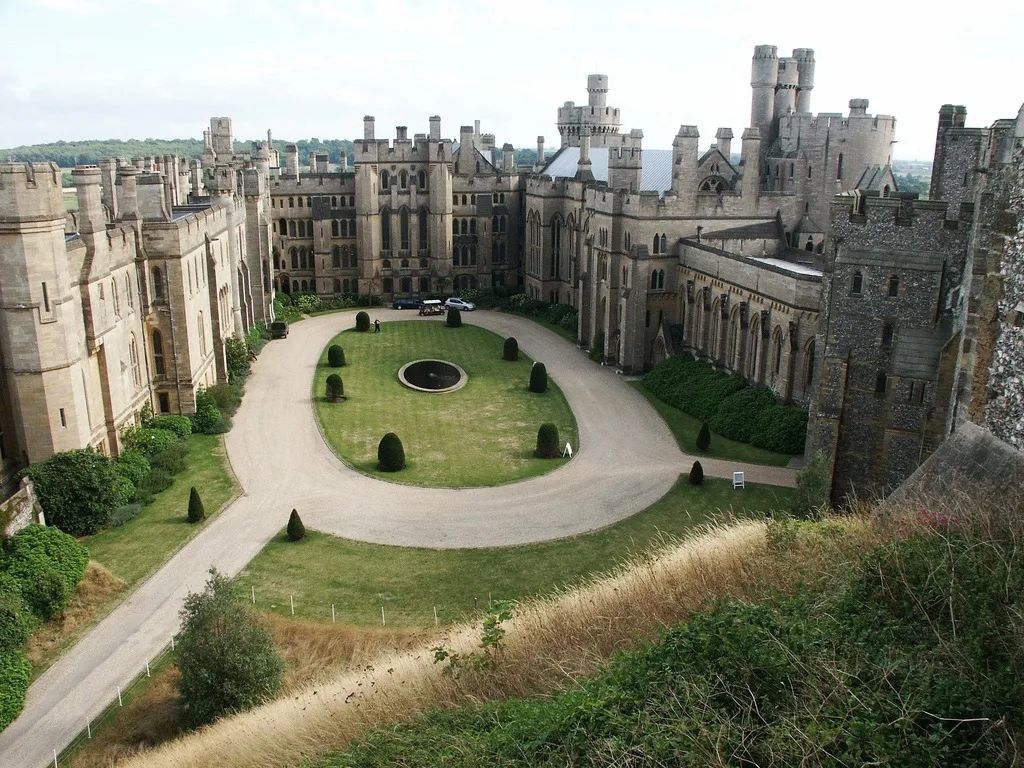Arundel, This attractive town is dominated by the magnificent presence of its castle. Arundel Castle, built in the late 11th century by Roger de Montgomery, Earl of Arundel, was granted to the city by William the Conqueror. It is a strong fortress, guarding the city of Arundel and the river Arun that runs through it.
 |
| Arundel Castle |
The history of Arundel Castle stretches back almost a thousand years, and throughout this period the castle and its inhabitants have witnessed all the great events in the history of English life.
It can be said that the castle has remained intact from 1138 to the present day. For a long time it was the seat of the Duke and Duchess of Norfolk, great lords of England for over 850 years. Many influential people have emerged from it, such as two cardinals and a saint, Saint Philip Howard, 13th Lord of Arundel, who died in 1595 in the Tower of London when he did not want to abandon Christianity.
 |
| Arundel Castle |
Throughout history, the castle has been visited by the vast majority of reigning monarchs. Queen Victoria visited him with Prince Albert, and stayed there for three days. Much of the furniture that we can see today is that of Queen Victoria herself, and Queen Mary of Scotland.
Many other treasures that we can see in the castle are several portraits of the painters Van Dyck, Gainsborough and Reynolds. There is a magnificent collection of furniture, clocks and tapestries. The castle is still a family home, since the Duke and his family live in it, so it is only open seasonally. But, if you want to travel back in time, a visit to Arundel Castle becomes a must.
 |
| Arundel Castle |
Everything around the castle is frankly magnificent. Sheep and cows graze on the meadow, almost hidden behind the walls. Further down in Arundel, there are other buildings that are worth seeing, such as the 14th century Church of San Nicolás and the magnificent Church of Our Lady and that of San Felipe Neri.
Arundel is just a stone's throw from the beaches of Bognor Regis, Middleton on Sea and Littlehampton. If you wish, you can also spend a good part of your time in the antique shops in the city center. Whatever you choose to do will always carry the spell of Arundel Castle, one of the most beautiful ancient stories in England.
 |
| Arundel Castle |
Quirky, fun and cosmopolitan, a short break in Arundel combines a thousand years of history with opportunities for hiking, canoeing and biking in the South Downs National Park, on the River Arun or on the coast.
A Gothic cathedral and Arundel Castle, seat of the Dukes of Norfolk, dominate the skyline. Set in 40 hectares of extensive grounds and gardens, Arundel Castle is open in high season and is the second largest castle in England with valuable works of art and the Earl Collector's Garden. It is a restored medieval castle.
 |
| Arundel Castle |
It was damaged in the English Civil War and later restored in the 18th and 19th centuries. Its construction was started by Roger de Montgomery on Christmas Day 1067. Roger was the first Earl of Arundel by concession from William the Conqueror. Beginning in the 11th century and for more than 400 years, the castle has been the hereditary manor house of the Dukes of Norfolk. It is still the headquarters of the Norfolk Family.
A Victorian and King George town, Arundel is famous for antique shops, retail stores and contemporary art galleries, which make shopping a real pleasure. Foodie enthusiasts will enjoy the monthly farmers market as well as some of the best restaurants and pubs in the region. Where better to buy local products to enjoy them on a picnic by the river? Just a short stroll from the city center is the Arundel Wetland Area, 26 hectares of wilderness landscapes that kingfishers, water rats and hundreds of wild birds call home.
 |
| Arundel Castle |
Arundel Lido is one of the few remaining heated outdoor pools in the south of England. The Farmers Market takes place on the third Saturday of each month.
The Parish Church of St Nicholas, built in 1380, is the only church in England to host the celebrations of the Anglican Church and the Catholic Church under the same roof. The two churches are separated by a glass screen that may have originally been a wall. The Catholic area is the Fitzalan Chapel which is where the Dukes of Norfolk are buried.
